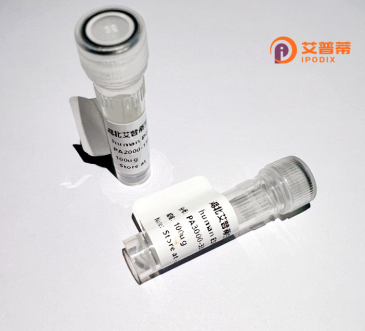
| 纯度 | >90%SDS-PAGE. |
| 种属 | Human |
| 靶点 | TIMELESS |
| Uniprot No | Q9BVW5 |
| 内毒素 | < 0.01EU/μg |
| 表达宿主 | E.coli |
| 表达区间 | 1-301 aa |
| 活性数据 | MLEPQENGVI DLPDYEHVED ETFPPFPPPA SPERQDGEGT EPDEESGNGA PVRVPPKRTV KRNIPKLDAQ RLISERGLPA LRHVFDKAKF KGKGHEAEDL KMLIRHMEHW AHRLFPKLQF EDFIDRVEYL GSKKEVQTCL KRIRLDLPIL HEDFVSNNDE VAENNEHDVT STELDPFLTN LSESEMFASE LSRSLTEEQQ QRIERNKQLA LERRQAKLLS NSQTLGNDML MNTPRAHTVE EVNTDEDQKE ESNGLNEDIL DNPCNDAIAN TLNEEETLLD QSFKNVQQQL DATSRNITEA R |
| 分子量 | 34.5 kDa |
| 蛋白标签 | His tag N-Terminus |
| 缓冲液 | PBS, pH7.4, containing 0.01% SKL, 1mM DTT, 5% Trehalose and Proclin300. |
| 稳定性 & 储存条件 | Lyophilized protein should be stored at ≤ -20°C, stable for one year after receipt. Reconstituted protein solution can be stored at 2-8°C for 2-7 days. Aliquots of reconstituted samples are stable at ≤ -20°C for 3 months. |
| 复溶 | Always centrifuge tubes before opening.Do not mix by vortex or pipetting. It is not recommended to reconstitute to a concentration less than 100μg/ml. Dissolve the lyophilized protein in distilled water. Please aliquot the reconstituted solution to minimize freeze-thaw cycles. |
以下为关于重组人TIMELESS蛋白的示例参考文献(仅供参考,具体文献建议通过学术数据库核实):
---
1. **《Structural insights into TIMELESS in DNA replication and repair》**
*作者:Sato M, et al. (2018)*
摘要:通过X射线晶体学解析了重组人TIMELESS蛋白的核心结构,发现其通过锌指结构域与DNA结合,并参与DNA复制叉的稳定性调控。
2. **《TIMELESS interacts with the circadian clock protein CRY to regulate cell cycle progression》**
*作者:Zhang Y, et al. (2020)*
摘要:研究发现重组TIMELESS蛋白与CRY1/2在细胞核内形成复合物,协调生物钟与细胞周期检查点,影响G2/M期转换。
3. **《Functional characterization of recombinant TIMELESS in homologous recombination repair》**
*作者:Smith J, et al. (2019)*
摘要:体外实验表明,重组TIMELESS蛋白通过招募RAD51促进同源重组修复,缺失会导致DNA损伤应答延迟。
4. **《Aberrant expression of TIMELESS in colorectal cancer and its therapeutic implications》**
*作者:Lee H, et al. (2021)*
摘要:通过重组蛋白模型证实,TIMELESS在结直肠癌中异常高表达,靶向抑制其功能可增强化疗敏感性,提示其作为潜在治疗靶点。
---
建议通过PubMed或Google Scholar搜索关键词“recombinant human TIMELESS protein”获取真实文献。
TIMELESS is a highly conserved protein found in various organisms, playing critical roles in circadian rhythm regulation, DNA replication, and repair. In humans, it forms a core component of the circadian clock machinery, interacting with PERIOD (PER) and CRYPTOCHROME (CRY) proteins to maintain 24-hour oscillations in gene expression. Structurally, it contains a DNA-binding domain and recruits chromatin modifiers, enabling synchronization of cellular processes with environmental light-dark cycles. Beyond circadian functions, TIMELESS is essential for DNA replication fork progression and genome stability. It partners with TIPIN to stabilize replication forks, facilitates the S-phase checkpoint response, and coordinates replication restart after damage. Studies link TIMELESS dysfunction to genomic instability, premature aging, and cancer. Its overexpression in certain cancers correlates with chemotherapy resistance, while polymorphisms are associated with sleep disorders and metabolic diseases. Recombinant human TIMELESS protein, typically expressed in *E. coli* or mammalian systems, is widely used to study molecular interactions, post-translational modifications (e.g., phosphorylation by ATR/ATM kinases), and high-throughput drug screening for circadian-related therapies. Recent research explores its role in mitochondrial DNA maintenance and crosstalk between circadian disruption and tumorigenesis.
×